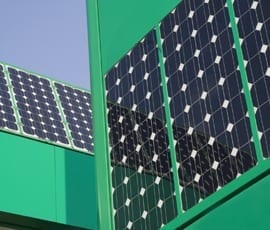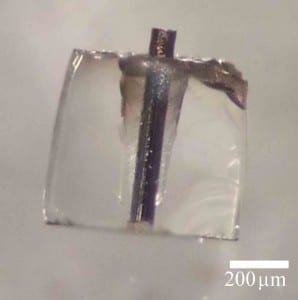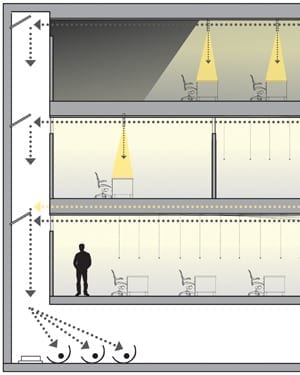
The researchers grew billions of tiny rods (nanorods) made from zinc oxide, then covered them with an active polymer to form a device that converts sunlight into electricity.
Playing pop and rock music improves the perfomance of solar cells, according to new research from scientists at Queen Mary University of London and Imperial College London.
The high frequencies and pitch found in pop and rock music cause vibrations that enhanced energy generation in solar cells containing a cluster of ‘nanorods’, leading to a 40 per cent increase in efficiency of the solar cells.
The study has implications for improving energy generation from sunlight, particularly for the development of new, lower cost, printed solar cells.
Using the special properties of the zinc oxide material, the team was able to show that sound levels as low as 75 decibels (equivalent to a typical roadside noise or a printer in an office) could significantly improve the solar cell performance.
“After investigating systems for converting vibrations into electricity this is a really exciting development that shows a similar set of physical properties can also enhance the performance of a photovoltaic,” said Dr Steve Dunn, Reader in Nanoscale Materials from Queen Mary’s School of Engineering and Materials Science and co-author of the paper.
Scientists had previously shown that applying pressure or strain to zinc oxide materials could result in voltage outputs, known as the piezoelectric effect. However, the effect of these piezoelectric voltages on solar cell efficiency had not received significant attention before.
“We thought the soundwaves, which produce random fluctuations, would cancel each other out and so didn’t expect to see any significant overall effect on the power output,” said James Durrant, Professor of Photochemistry at Imperial College London, who co-led the study.
“We tried playing music instead of dull flat sounds, as this helped us explore the effect of different pitches. The biggest difference we found was when we played pop music rather than classical, which we now realise is because our acoustic solar cells respond best to the higher pitched sounds present in pop music,” he concluded.
Go deeper with Bing News on:
Acoustic solar cells
- Appledore Island solar array expanding for UNH-led ocean cable project
A 30-kilowatt solar array will be installed on Appledore Island to benefit a cabled acoustic array project conducted by the University of New Hampshire on the Isles of Shoals’ largest island. The ...
- Appledore Island solar array expanding for UNH-led ocean cable project
The structure will be expanded to include six new arrays, with 14 solar panels on each ... on Appledore Island to send data from offshore acoustic sensors. The sensors are used to collect data ...
- Curaçao Hunts For Sustainability In The Caribbean—And A Lionfish Or Two
Hotels on Curaçao are doing everything from reef cleanup to next-level conservation initiatives to preserve the fragile Caribbean ecosystem.
- Dhruva Space gets ₹14 crore funding from DST’s tech development board
Hyderabad-based Dhruva Space receives ₹14 crore for innovative space-grade solar array fabrication and testing facility.
- Dhruva Space's aligns with TDB's mission to promote innovation in space engineering- Secretary, TDB
TDB has sanctioned financial assistance for this space startup, demonstrating its confidence in the project's potential to drive technological advancements in the space industry.
Go deeper with Google Headlines on:
Acoustic solar cells
[google_news title=”” keyword=”Acoustic solar cells” num_posts=”5″ blurb_length=”0″ show_thumb=”left”]
Go deeper with Bing News on:
Solar cells
- KIT researchers develop18.2%-efficient perovskite solar cell via scalable inkjet process
Researchers at Karlsruhe Institute of Technology (KIT) have developed a scalable two-step evaporation and inkjet process for perovskite thin-film solar cells. The new technique reportedly enables to ...
- China’s Solar Panel Giants Say Prices Are Near the Bottom
(Bloomberg) -- Plunging prices for solar panels, which have slashed profits across the sector, don’t have much room to fall further, according to the chairmen of two of the industry’s biggest firms.
- Efficacy of solar panels boosted
Solar energy is a crucial asset in the fight against climate change, and researchers have now devised a smart approach to optimize its effectiveness. Their innovative method includes incorporating ...
- Solar surprise: Homeowners hit with big bills for panels they say they didn't buy
The CBS News Texas I-Team has been looking into complaints about the solar panel industry for the past several months. Read our latest story here. GARLAND — Kim Kromdyk doesn't have solar panels. Not ...
- This company just launched red solar panels to match terracotta tiled roofs
Austria's Sonnenkraft has debuted its new "Terracotta" solar panel that matches red-tiled roofs and is historic-building compliant.
Go deeper with Google Headlines on:
Solar cells
[google_news title=”” keyword=”solar cells” num_posts=”5″ blurb_length=”0″ show_thumb=”left”]










